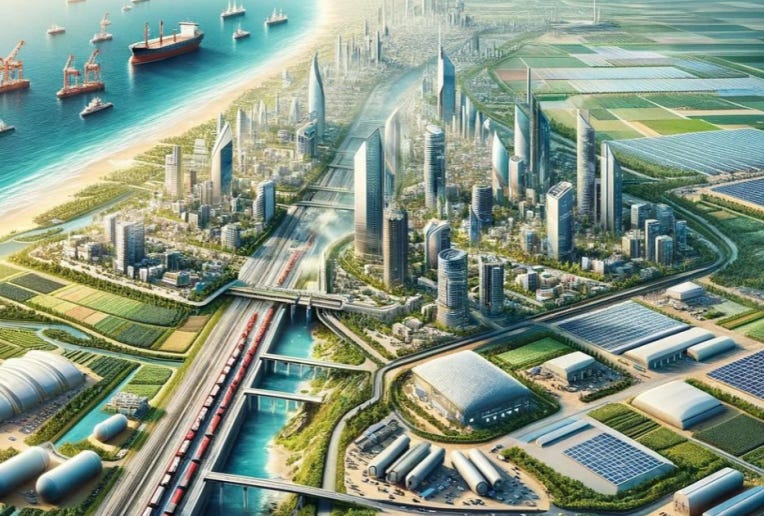Trump Recycles Netanyahu’s ‘Gaza 2035 Plan’
Regional complicity is key to the plan's success and it is happening despite denials.
Recent statements by US President Donald Trump put forward that Jordan and Egypt would accept refugees from Gaza, both for reconstruction efforts and permanent displacement. Although deemed controversial and somewhat unrealistic, this idea is based on an existing plan published by the Israeli Prime Minister’s office last year, which envisions Gaza becoming a central manufacturing and trading hub, linking Israel with Egypt, and funded by the Gulf as part of the India-Middle East Economic Corridor (IMEC). Despite statements refusing to accept the idea and reports claiming Jordan’s willingness to take military action over it, there is substantial evidence of Jordan and Egypt’s complicity in Netanyahu’s initial plan: both countries have taken significant steps to secure their future along the trade route that would require Gazans displacement.
Netanyahu’s 2024 Ethnic Cleansing Plan
Trump’s controversial statements may have been misspoken, but his point about Jordan and Egypt's involvement holds some validity. The plan he referenced was an actual proposal published by Israeli Prime Minister Netanyahu's office in the spring of last year titled ‘From Crisis to Prosperity – Plan for the Transformation of Gaza Strip’. It outlined three stages: first, humanitarian aid provision for one year; second, establishing a Gaza Rehabilitation Authority (GRA) made up of normalising Arab countries (Bahrain, Egypt, Jordan, Morocco, Saudi Arabia, and the UAE); and third, setting up a non-Hamas ‘Gazan self-rule’. The ultimate goal, according to the plan, is to have Gaza join the Abraham Accords as a key transit point and economic hub for Israel and Egypt. The economic hub will establish Northern Gaza and Sderot as an electric vehicle manufacturing center, using the Gaza Marine gas field for power, with products transported from the Al-Arish port to Europe. While these proposals may seem unrealistic, the plan is real and relies on depopulating parts of Gaza and transforming the Strip into an international zone for regional and global businesses. Ultimately, it serves as a smokescreen to reframe the ethnic cleansing of Palestinians in Gaza for the subsequent long sought after Israeli annexation.
Egypt and Jordan Preparation for IMEC
Despite their initial refusal to officially sign the MoU for the IMEC with France, Germany, India, Italy, Saudi Arabia, the US, UAE, and the EU in September 2023, Jordan and Egypt have since effectively adopted this project. In May 2024, MENAUnleashed reported Egypt's efforts to join the initiative. Since then, Egypt has made significant progress, building a railway, a new port, and opening several factories near Gaza—all completed in 2024. The main port for shipping will be East Port Said, located in the Sinai Peninsula, which recently signed a framework agreement with the Egyptian government to establish an industrial zone. The port would serve as a key pillar in an Abraham Accords-aligned Gaza, and continues to attract investment from the Gulf, with expansion work set to begin in April of this year.
Similarly, Jordan has taken significant steps after 7 October, signing contracts to build railways, pipelines, and energy and water projects under the IMEC vision. This includes the French-led water desalination deal, followed by the Kingdom’s recent Strategic and Comprehensive Partnership with the EU. More notably, it includes the newly-signed Jordan-UAE railway network deal and the Saudi-Jordan Aqaba railway project which completes the connection to Saudi’s NEOM specifically mentioned in the Israeli Vision. In conclusion, amidst regional political shifts, Jordan and Egypt's actions suggest growing alignment with Israel's vision for Gaza. Their infrastructure projects and partnerships indicate complicity in transforming Gaza into a regional hub, raising concerns about the displacement of its people.



